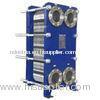Stainless Steel Plate Heat Exchanger / Chiller Accessories For Clean Water, River Water
small heat and resistance loss;
high heat transfer efficiency;
flexible operation,easy installation;
competitive price.
A plate heat exchanger is a unit which transfers heat continuously from one media to another media without adding energy to the process. The basic concept of a plate and frame heat exchanger is two liquids flowing on either side of a thin corrugated metal plate so heat may be easily transferred between the two.
The plates are compressed by means of tie bolts between a stationary frame part (called the head) and a movable frame part (called the follower).
The plate heat exchanger efficiency requires less floor space compared to other types of heat transfer equipment and is lighter in weight
The plate heat exchanger (PHE) is a specialized design well suited to transferring heat between medium- and low-pressure fluids.
In place of a pipe passing through a chamber, there are instead two alternating chambers, usually thin in depth, separated at their largest surface by a corrugated metal plate.
The plates used in a plate and frame heat exchanger are obtained by one piece pressing of metal plates. Stainless steel is a commonly used metal for the plates because of its ability to withstand high temperatures, its strength, and its corrosion resistance.
The plates are often spaced by rubber sealing gaskets which are cemented into a section around the edge of the plates. The plates are pressed to form troughs at right angles to the direction of flow of the liquid which runs through the channels in the heat exchanger. These troughs are arranged so that they interlink with the other plates which forms the channel with gaps of 1.3–1.5 mm between the plates.


